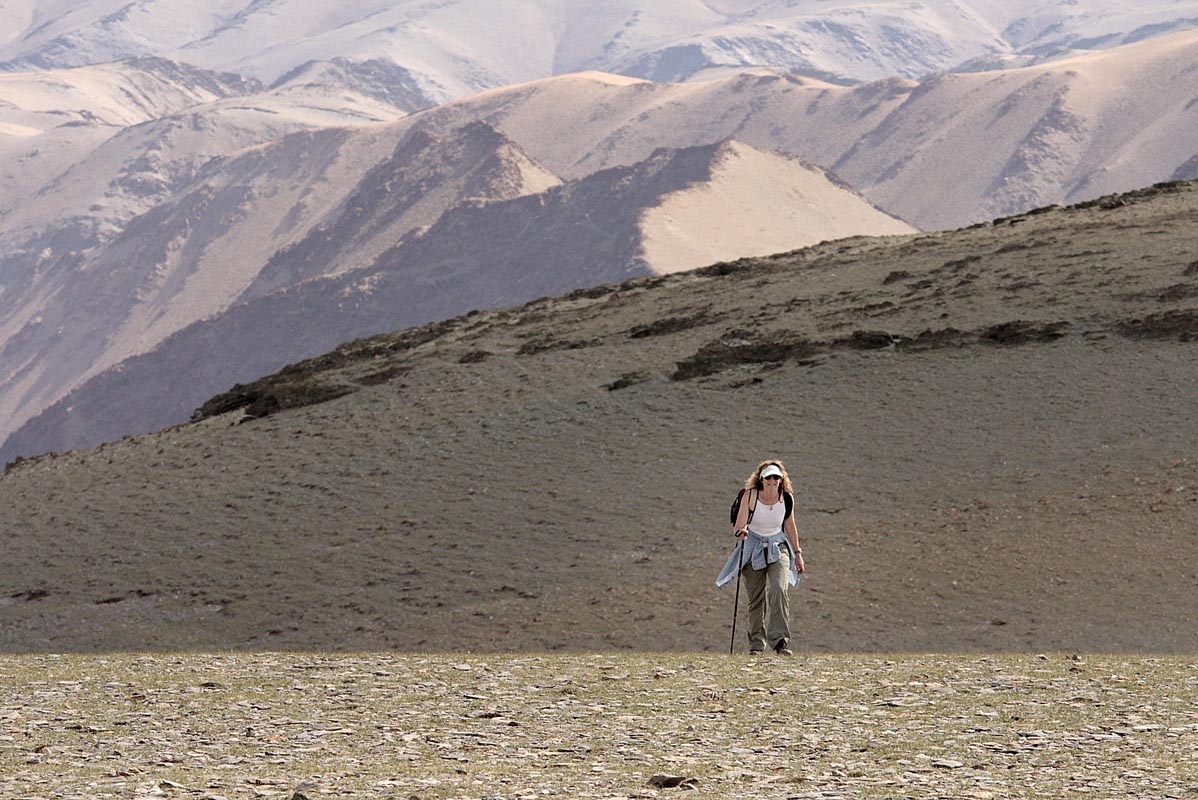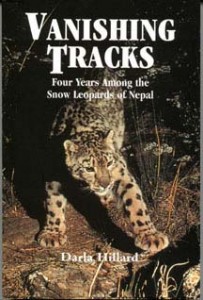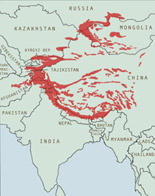
Tom McCarthy and his team studying the map of snow leopard tracks in Mongolia. Photo Nic Bishop.
“Saving the ghost of the mountain – an expedition among snow leopards in Mongolia”.
I’ve recently been in touch with Sy and here she shares the story of her travels and her book.
Sy and her photographer colleague, Nic Bishop have previously done four books together–on topics ranging from tarantulas in French Guiana to tree kanagroos in Papua New Guinea.
“But “Saving the ghost of the mountain” was our most remote, difficult, and physically challenging book yet,” Sy said.
“Nic and I were thrilled to be going to the Altai Mountains of the Great Gobi. We had always dreamed of visiting the land of Genghis Khan, the site of the first discovery of dinosaur eggs, the world’s second-largest desert–and the land of perhaps one-third of the world’s snow leopards. Our spouses were less thrilled. Talk about remote! This is, after all, what used to be called “Outer Mongolia”–as if Inner Mongolia were some sort of global center. We soothed nervous spouses by bringing a rented satellite phone in case of emergency.”

Sy on camel – best transport in Mongolia. Photo by Nic Bishop.
As if the remote location and the physical demands of long distance walking in Mongolia wasn’t enough, Sy was actually doing this trip with a really bad ankle!
“Yes, I left home with a bad ankle. To look for signs of snow leopards, we spent our days climbing slopes slippery with rocky scree at altitude. For me, this physical challenge was considerably compounded by my injury. I had sprained my ankle that spring, and had to complete a book tour on crutches. After months of physical therapy it had finally healed–but then, the Tuesday before I stepped on the plane to Mongolia, I twisted it in a chipmunk hole by our barn. I didn’t mention this to Tom when we set out. My greatest fear was that I would slow down the expedition. Happily everyone was so busy collecting scat samples along the way that I usually had time to catch up with the rest of the team. And when I did fall, everyone was wonderfully kind and understanding. Though Nic was usually the one stuck picking me up off the stony ground, everyone on the trip got a chance to do so at least once during the expedition!”

Sy trekking in rugged snow leopard terrain, Mongolia. Photo by Nic Bishop.
I’ve often thought it must be hard doing a book about an animal that you actually never end up seeing. Peter Matthiessen, the great nature writer had the same challenge with his wonderful book “The Snow Leopard’ published first in 1978.
I asked Sy this question and she agrees the challenges are real.
“ We knew from the start that we would probably never see our quarry. How to make it vivid for the young readers who, like Nic and me–and everyone else on the expedition–yearned to see a snow leopard? Again, Tom was wonderfully accommodating. In the evenings, when he was surely exhausted and had notes of his own to write up, he would tell us stories about the leopards he had previously collared and tracked. With these stories and Nic’s gorgeous photos of captive animals in zoos, we were able to enliven our pages with glimpses of snow leopards that Nic and I didn’t actually witness on our trip–but that we were still able to enjoy and learn from nonetheless. Tom is a magnificent storyteller! So even though we never saw a snow leopard, he was able to conjure a ghost so our readers could “meet” snow leopards face-to-face in our book.
The trip was magic like this in so many ways. Though I was injured and sore, I always felt cared-for and safe. Though we were very far away from home, we always felt welcome. The hospitality of the Mongolian people we met was heartwarming: at every ger (or yurt – the tent-like homes of these nomadic people) we visited, out came the milk tea, the towers of sliced bread, the platters of dried cheese…and invariably, piles of meat, which as a vegetarian I cannot eat. (After 30 years without meat, my stomach can’t digest it.) Yet these folks were so kind and so hospitable that they even were able to forgive the fact that I couldn’t eat their meat–even though vegetarianism is unheard-of (and impossible) in a country where people eat almost nothing but milk and meat. I still don’t know how our Mongolian colleagues Bayara and Nadia explained this to our hosts. (I guess they must have told them I had some terrible disease.)”
In her journal Sy writes about many of the Mongolian people they met up with, including a great wedding feast which featured huge amounts of food and a passing snuff bottle that all the guests sniffed.
“Nic and I will always remember this expedition as one of the most exciting of our lives. We’ll always be grateful to Tom and to Kim, Nadia and Bayara as well as our cook Enke and driver Munko, and to all the great Mongolian herders we met. And we’ll always be grateful to the REAL owners of the land we visited: the snow leopards, who we never saw–but who, more importantly, surely saw us. “
Thanks Sy for sharing stories from your adventure, hope the ankle has healed finally and take care with chipmonk holes  You can read more about Sy and her books on her website here.
You can read more about Sy and her books on her website here.
“Vanishing tracks – four years among the snow leopards of Nepal.”
 This book by Darla Hillard is about Rodney Jackson’s early work capturing and radio collaring snow leopards in Nepal. This book is another classic in the Snow Leopards genre, with it’s gripping story of the very first radio collaring of wild snow leopards in the early 1980’s. Darla has been Rodney’s companion and assistant for many years and this book tells in detail the hard work their team did, not only in the field with the wild cats but also the tireless fund raising to get money for snow leopard conservation projects at a time when few people in the west had even heard of these beautiful cats.
This book by Darla Hillard is about Rodney Jackson’s early work capturing and radio collaring snow leopards in Nepal. This book is another classic in the Snow Leopards genre, with it’s gripping story of the very first radio collaring of wild snow leopards in the early 1980’s. Darla has been Rodney’s companion and assistant for many years and this book tells in detail the hard work their team did, not only in the field with the wild cats but also the tireless fund raising to get money for snow leopard conservation projects at a time when few people in the west had even heard of these beautiful cats.
There’s elation as the team captures and collars five cats altogether, a fantastic scientific and research feat at the time. This work produced a landmark study that has helped subsequent researchers understand many of the secrets of the elusive and endangered snow leopard, ultimately helping towards the cat’s survival in the wild. The book also explores the lives of the mountain people who share the cat’s habitat for whom the team had an obvious affection.
The team stayed in the remote and dramatic Langu Gorge four seasons and during that time experienced extreme weather including one of the worst winter snow seasons in the region’s living memory, major monsoon rains and the isolation and danger of being at high altitudes in remote areas a two-week hike away from the nearest airstrip. At one time Rodney suffered a snow leopard bite from a cat that didn’t realise it was helping science and the species future J and the team had to postpone the study for a month while Rodney got treatment.
Rodney is the founder and Director of the Snow Leopard Conservancy (SLC) which has over thirty years of snow leopard conservation and community development to its credit. He has been nominated for the 2010 Indianapolis Prize, the most prestigious endangered species conservation prize in the world. Today Darla coordinates the Snow Leopard Conservancy’s programs, manages the office, and directs small-scale field-based conservation education activities.
Reviews of “Vanishing Tracks”
….Hillard gives us a splendid vicarious adventure that ranges from enduring blizzards with only a tent for shelter to the elation of observing a leopard with cubs… Publishers Weekly.
….remarkable tale of extraordinary dedication, perseverance, and accomplishment… encompasses the people and personal adventure – the daunting climbs, ferocious snowstorms, and equally ferocious flies, bedbugs, and thorny plants … Adventure, ecology, politics, heroes and villains – something for everyone here, even those afraid of heights. Kirkus Reviews.

Cover of ‘Irbis, the Snow Leopard’ – book by Oleg and Irina Loginov from Kazakhstan.
“Irbis, the snow leopard” by Oleg and Irina Loginov.
Oleg and Irina Loginov are fighting to save the snow leopard in Kazakhstan and this book is photographic journey through snow leopard habitat and the challenges they face in their range countries. The book is also a fund raiser for the Loginov’s Kazakhstan Snow Leopard Fund. Read more about the book here.

Oleg Loginov with his book.





